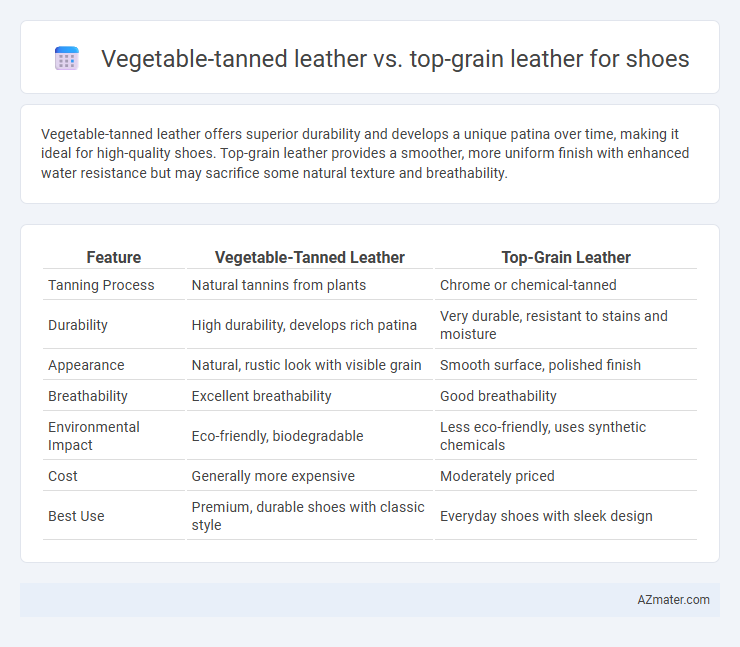Vegetable-tanned leather offers superior durability and develops a unique patina over time, making it ideal for high-quality shoes. Top-grain leather provides a smoother, more uniform finish with enhanced water resistance but may sacrifice some natural texture and breathability.
Table of Comparison
| Feature | Vegetable-Tanned Leather | Top-Grain Leather |
|---|---|---|
| Tanning Process | Natural tannins from plants | Chrome or chemical-tanned |
| Durability | High durability, develops rich patina | Very durable, resistant to stains and moisture |
| Appearance | Natural, rustic look with visible grain | Smooth surface, polished finish |
| Breathability | Excellent breathability | Good breathability |
| Environmental Impact | Eco-friendly, biodegradable | Less eco-friendly, uses synthetic chemicals |
| Cost | Generally more expensive | Moderately priced |
| Best Use | Premium, durable shoes with classic style | Everyday shoes with sleek design |
Introduction: Understanding Leather Types in Shoemaking
Vegetable-tanned leather, crafted using natural tannins from plant materials, offers durability and a rich, developing patina ideal for high-quality shoes. Top-grain leather, derived from the outer layer of the hide and sanded to remove imperfections, provides a smooth, uniform finish with enhanced resistance to moisture and stains. Both leather types are prized in shoemaking, with vegetable-tanned leather emphasizing natural aging and top-grain leather focusing on refined appearance and durability.
What Is Vegetable-Tanned Leather?
Vegetable-tanned leather is derived from natural tannins found in tree bark, leaves, and other plant materials, offering a traditional and eco-friendly tanning process that enhances durability and develops a rich patina over time. This type of leather retains the natural characteristics of the hide, providing a firm yet flexible texture ideal for high-quality shoes. Compared to top-grain leather, vegetable-tanned leather ages uniquely, gaining character through exposure to light and oils, making it a preferred choice for artisanal and premium footwear.
What Is Top-Grain Leather?
Top-grain leather is the second-highest grade of leather used in shoe manufacturing, created by sanding and buffing the top layer of the hide to remove imperfections while retaining a smooth surface. Unlike vegetable-tanned leather, which uses natural tannins and develops a rich patina over time, top-grain leather undergoes chemical tanning for enhanced durability and water resistance. This treatment makes top-grain leather highly durable, flexible, and more resistant to stains, making it a popular choice for high-quality dress shoes.
Appearance and Texture Comparison
Vegetable-tanned leather features a rich, natural patina that deepens with age, offering a warm and authentic appearance ideal for high-quality shoes. Top-grain leather provides a smoother, more uniform surface due to its refined sanding process, resulting in a polished and consistent texture favored in formal footwear. While vegetable-tanned leather showcases visible grain and slight imperfections that add character, top-grain leather emphasizes sleekness and durability with minimal surface variation.
Durability and Longevity
Vegetable-tanned leather offers exceptional durability due to its natural tanning process, which strengthens the fibers and allows the leather to develop a unique patina over time, enhancing its longevity for shoe use. Top-grain leather, while more refined and resistant to stains, tends to be thinner and less robust than vegetable-tanned leather, potentially resulting in a shorter lifespan under heavy wear conditions. Shoes made from vegetable-tanned leather are often preferred for their ability to withstand daily wear and improve in appearance with age, making them a durable long-term investment.
Environmental Impact and Sustainability
Vegetable-tanned leather, produced using natural tannins from tree bark and plant materials, offers a more eco-friendly alternative to chrome-tanned top-grain leather, which relies on toxic chemicals harmful to ecosystems. Vegetable tanning processes generate less water pollution and are biodegradable, contributing to lower environmental footprints in sustainable shoe manufacturing. While top-grain leather provides durability and uniformity, its chemical-intensive production raises concerns about long-term sustainability and waste management in fashion industries.
Comfort and Wear Over Time
Vegetable-tanned leather provides a firm yet breathable feel, molding to the foot over time for personalized comfort, while developing a rich patina with prolonged use. Top-grain leather is smoother and more flexible initially, offering immediate comfort, but may show wear more quickly due to its thinner surface layer. Both types improve comfort through break-in, but vegetable-tanned leather typically offers greater durability and character with long-term wear.
Cost Differences and Value for Money
Vegetable-tanned leather typically costs more upfront than top-grain leather due to its longer, eco-friendly tanning process and natural aging properties, making it a premium choice for shoe craftsmanship. Top-grain leather offers a more affordable price point with good durability and a smooth finish, but it may not develop the unique patina and longevity characteristic of vegetable-tanned leather. For value-conscious buyers seeking long-term wear and aesthetic appeal, vegetable-tanned leather shoes provide better investment, whereas top-grain leather suits those prioritizing cost-efficiency and immediate wearability.
Best Uses: Which Leather for Which Style?
Vegetable-tanned leather excels in durability and develops a unique patina, making it ideal for classic, heritage-style shoes such as brogues and boots that benefit from aging and timeless appeal. Top-grain leather offers a smooth, refined finish with greater water resistance, suited for formal dress shoes and modern loafers requiring sleek aesthetics and easy maintenance. Selecting vegetable-tanned leather suits rugged or casual footwear, while top-grain leather is best for polished, professional styles.
Conclusion: Choosing the Right Leather for Your Shoes
Choosing between vegetable-tanned leather and top-grain leather depends on your priorities for shoe durability, comfort, and appearance. Vegetable-tanned leather offers natural aging and breathability, ideal for those who appreciate a unique patina and eco-friendly materials, while top-grain leather provides a smoother finish, greater resistance to stains, and easier maintenance. Assessing factors like climate, usage frequency, and personal style will guide you to select the leather that best suits your footwear needs.

Infographic: Vegetable-tanned leather vs Top-grain leather for Shoe
 azmater.com
azmater.com